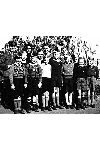The Sydney was lost with all hands. Survivors of the Kormoran were captured after 7 days in lifeboats.
Tatura Irrigation and Wartime Camps Museum
The original four roomed building, c.1888, from which the irrigation scheme for the Western Goulburn Valley was developed, was purchased and restored in 1988. This building now houses local history and information on the history of irrigation. Two brick extensions, totalling 200 sq. metres have since been added to house the Wartime Camps collection, included is a foyer, shop and lecture room come art gallery complete with video viewing facilities.
Subject:
- Historical Society
- House Museum
- Social History Museum
- Archives
- Armed Forces
- Childhood
- Domestic Items
- EducationAndSchools
- Historic Buildings
- Local Government
- Local History
- Maritime and Naval History
- Medals and Badges
- Migration
- Organisations
- Philately
- Prisons or Convicts
- Social History
- Agriculture
- Clothing, Fashion, Costume
- Engineering
- Horticulture
- Industry
- Postal Services
- Gardens
- Dance
- Dolls
- Literature
- Models
- Performing Arts
- Sports
- Theatre
- Toys and Games
Items
Photograph
German POW Sailor

Photograph
Camp 3 Children

Internees conducted Kinder, Primary and Secondary schools within the camp. Good relations existed between internees and army guards.
Photograph
German War Cemetery

Italian war cemetery at Murchison, 25kms from the Tatura Museum. Japanese war cemetery at Cowra, near NSW.
Photograph
Dhurringle Mansion as German POW Camp

Built by squatter James Winter in 1875. Required by the Commonwealth in 1939 for internees then POWs. Subsequently a Presbyterian Boys Training Farm for British migrants.
